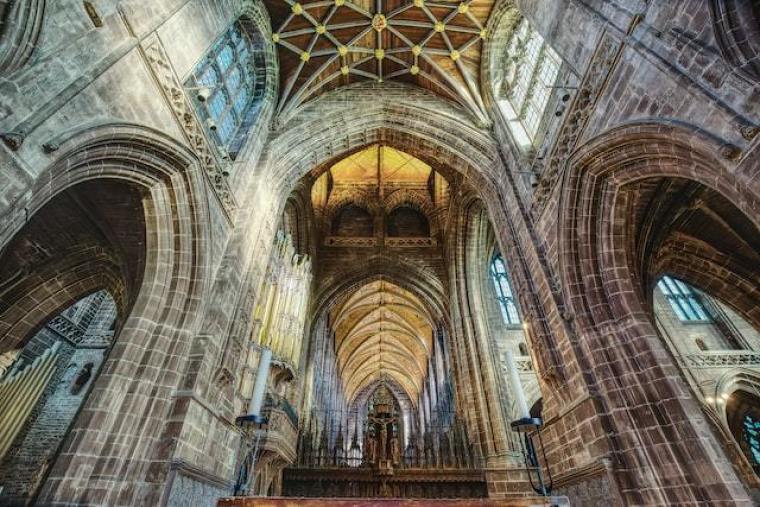
“But do not overlook the fact, beloved, that with the Lord one day is a thousand years, and a thousand years is a day”. (2 Peter 3:8)
Have you ever stepped out of time for a moment to imagine what history might look like all at once? As the end of 2022, amidst a crisis of housing shortage and affordability, my husband and I packed up our family home with our three children with no guarantee of a permanent accommodation. After countless rejected rental applications, we changed our tact and began the arduous process of acquiring a loan for a little apartment in the centre of Brisbane’s Fortitude Valley. By the grace of God and the generosity of friends and family, we were never without a bed to sleep; but for months our plans varied wildly from one day to the next, and the only certainty we could hold to was the certainty of God’s faithfulness, having never ceased to provide for our family.
On the 14th of September, 1928, the heritage sandstone wall outside my apartment window became the gathering place for 35,000 people as the foundation stone was laid for what would have been the largest cathedral in the southern hemisphere. I can almost see them gathered on the corner of Ann and Gotha Street; every class and creed, city councillors, clergymen, children sitting atop father’s shoulders, the faithful, the curious, all to witness an historic moment when the very heart of Brisbane would be dedicated to the Lord as a place for His worship, and refuge for His people. The Cathedral, however, was never developed beyond the retaining wall and a crypt that served as a chapel for a few brief years. Brisbane’s Archbishop, James “the builder” Duhig’s magnum opus would ultimately fall to ruin as the season shifted to financial crisis.
If I were to give in to my natural protestant discontent for the catholic church, I might greet the project’s failure with some quip about the vanity of building a grand cathedral for grandeur’s sake; I could draw the comparison that has been overstated since Luther that conflates our Catholic brothers with the pharisees of the New Testament; but as I look out at the sandstone balustrade, I am struck by my own pharisaical arrogance. As a Spirit-filled Pentecostal, I know I’m not the only one to have gently scoffed at the works of human hands, only to be humbled that the Spirit behind them is one and the same. How absurd we are to throw out the work of the Spirit because we cannot conceive that the Lord could heal on the sabbath.
The 1920s and 30s were defined by the wake of World War I and the Great Depression, but in the midst of need and hardship, the people hungered for something more. After the crowds had left and building ceased, the Holy Spirit was still at work building His kingdom in the heart of Brisbane. Word had spread that revival had taken hold in churches around Australia. In 1930, evangelist William Booth-Clibborn, grandson of the Salvation Army’s William Booth, arrived in Brisbane to preach the gospel. On Barry Parade, one street from the block designated for Duhig’s cathedral, a tent was erected. Within weeks, the tent walls needed to be expanded, with 2000 meeting every Sunday night and spilling into the streets of Fortitude Valley with joyous song. It became known as the “canvas cathedral”, and went on to become Glad Tidings Tabernacle, now known as Hope Centre; the church I call home.
While plans made in our limited human understanding fall subject to the nature of this world, where moth and rust destroy, our God’s purposes cannot go unfulfilled. It has been almost one hundred years since this land I live on was marked in covenant with the Lord; since thousands gathered outside my door in the hopeful expectation of God’s purposes; since thousands were saved in the Canvas Cathedral and found hope in a season of hopelessness.
“But do not forget this one thing, dear friends: With the Lord a day is like a thousand years, and a thousand years are like a day. 9 The Lord is not slow in keeping his promise, as some understand slowness. Instead, he is patient with you, not wanting anyone to perish, but everyone to come to repentance. (2 Peter 3:8-9)
While I cannot know for certain how this next season of revival will look for the city of Brisbane, I’ll recognise the promise of this place that is now my home; open to the work of the Holy Spirit in building His Cathedral, whether canvas or stone. As I look upon the balustrade outside my window, I’ll tarry in the sound of faith of those multitudes that came before.

Laura Wardrop has undertaken further study in the areas of Linguistics, Art, and Ministry. She currently works a graphic artist and painter, and takes a keen interest in exploring all areas of human creativity as a reflection of God’s character. She lives with her husband Stephen and two children in Brisbane.